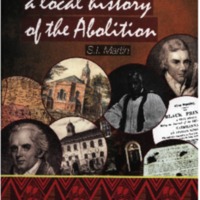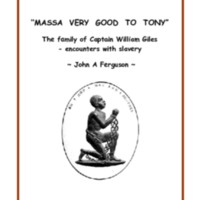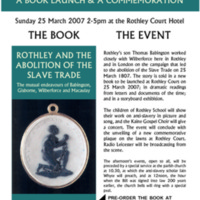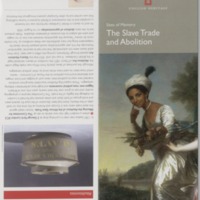
Lambeth and the Abolition
The Lambeth and the Abolition programme included debates, historic trails, a video conferencing discussion between people in Brixton, Ghana and Jamaica, Caribbean family history classes, creative writing workshops, and a dedicated series of events within Black History Month. ‘The Runaways’, an original drama about a runaway slave boy and a kitchen maid in London in 1700, was performed in Lambeth primary schools, accompanied by a workshop. The project researched the local historical links to abolition, and famously the activities of the Clapham Sect (William Wilberforce and his associates) who attended Holy Trinity Church in Clapham. A booklet by historian S. I. Martin sets the history of abolition in the larger context, through his study of the African Academy at Clapham, and his mapping of some of the links between Lambeth, Jamaica and West Africa at the beginning of the 19th century.

“Massa Very Good to Tony” The family of Captain William Giles - encounters with slavery
A lecture given to the Cumbria Family History Society Annual Conference in November 2007 was produced in booklet form and deposited in the Cumbria Record Office at Carlisle. To mark the bicentenary, John A. Ferguson researched the story of a former slave from Jamaica who lived in Cumberland. Captain William Giles of the British Army served in the West Indies in the 1780s, settling with his family in Jamaica. When the family returned to England, they brought with them James Anthony, known as "Tony", their former domestic slave. Tony was later servant to several other families in Carlisle, and is buried in St Mary's churchyard.

Rothley and the Abolition of the Slave Trade
A commemorative event to mark the bicentenary in Rothley, Leicestershire, was organised by a planning group of Rothley Parish Church and the Committee of the Rothley History Society. The event on 25 March 2007 launched a new book by Terry Sheppard and Iain Whyte, ‘Rothley and the Abolition of the Slave Trade’, which explored the ‘mutual endeavours’ of Thomas Babington, Thomas Gisborne, William Wilberforce and Zachary Macaulay. These men were linked though family and university connections, and their involvement in the campaign to abolish the slave trade. Many of their meetings took place at Babington’s home, Rothley Temple, now known as the Rothley Court Hotel, where the event in 2007 was held.
The day included dramatic readings from 18th century documents relating to the campaign for abolition, an exhibition of panels from Anti-Slavery International, an interview with a descendant of Thomas Babington, and a choir concert from the Kainé Gospel Choir. In collaboration with Charnwood Borough Council, a new plaque was unveiled to remember the suffering of African people and the part played in ending the trade by Babington, Wilberforce and others. In December 2007, the planning group invited organisations in Rothley and Leicester to submit items contemporary to 2007 to be placed in a time capsule, to be laid up at the court until the tricentenary in 2107. The oak casket sits behind glass in a niche at the hotel.

Sites of Memory: The Slave Trade and Abolition
The Sites of Memory project was the first research by English Heritage (now Historic England) to provide an overview for the public of the buildings, memorials and grave sites across England that reflects the role of the slave trade in British history, and resistance to it. The project explored the history of Black people in Britain during the 18th and 19th centuries by exploring the stories behind the historic built environment of local streets, buildings and landmarks. The research (by historians Angelina Osborne and S. I. Martin, on behalf of English Heritage) also identified sites associated with the slave trade and plantation wealth, and with the abolitionists who campaigned for an end to slavery. English Heritage also made recommendations for new listings for historic sites that mark the Black presence.

Bromley's Hidden History
‘Bromley’s Hidden History’ was led by Bromley Museum, with assistance from Bromley Local Studies and Archives. A touring exhibition, education pack, programme of events and web resources were produced to highlight Bromley’s connections with slavery and abolition. Bromley slave owners and those with capital invested in the Caribbean were highlighted, alongside the influence of William Pitt (who lived at Holwood House) and his political circle in the abolitionist campaign. Consideration was also given to historical black figures living in the borough, such as the actor Ira Aldridge.